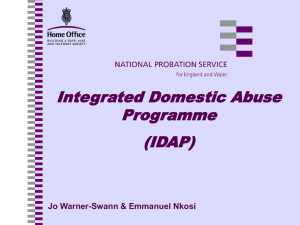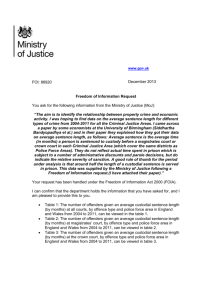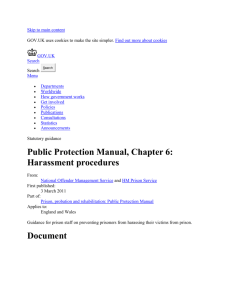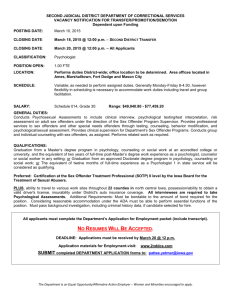The Arrangements for Sentencing in England and Wales
advertisement
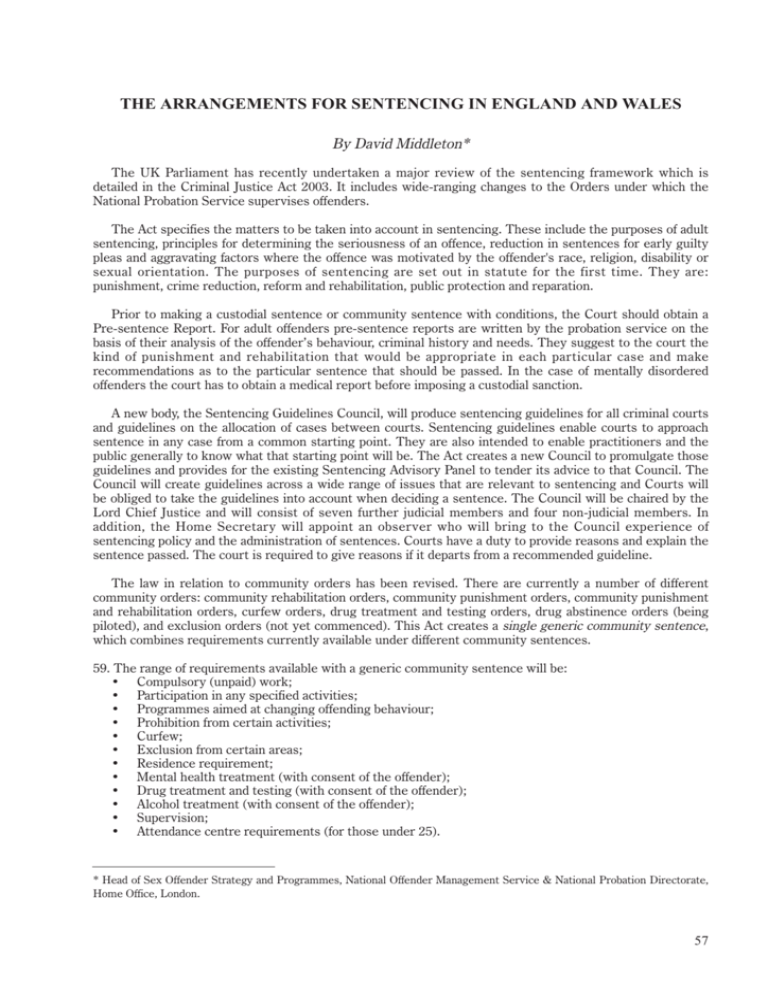
THE ARRANGEMENTS FOR SENTENCING IN ENGLAND AND WALES By David Middleton* The UK Parliament has recently undertaken a major review of the sentencing framework which is detailed in the Criminal Justice Act 2003. It includes wide-ranging changes to the Orders under which the National Probation Service supervises offenders. The Act specifies the matters to be taken into account in sentencing. These include the purposes of adult sentencing, principles for determining the seriousness of an offence, reduction in sentences for early guilty pleas and aggravating factors where the offence was motivated by the offender's race, religion, disability or sexual orientation. The purposes of sentencing are set out in statute for the first time. They are: punishment, crime reduction, reform and rehabilitation, public protection and reparation. Prior to making a custodial sentence or community sentence with conditions, the Court should obtain a Pre-sentence Report. For adult offenders pre-sentence reports are written by the probation service on the basis of their analysis of the offender’s behaviour, criminal history and needs. They suggest to the court the kind of punishment and rehabilitation that would be appropriate in each particular case and make recommendations as to the particular sentence that should be passed. In the case of mentally disordered offenders the court has to obtain a medical report before imposing a custodial sanction. A new body, the Sentencing Guidelines Council, will produce sentencing guidelines for all criminal courts and guidelines on the allocation of cases between courts. Sentencing guidelines enable courts to approach sentence in any case from a common starting point. They are also intended to enable practitioners and the public generally to know what that starting point will be. The Act creates a new Council to promulgate those guidelines and provides for the existing Sentencing Advisory Panel to tender its advice to that Council. The Council will create guidelines across a wide range of issues that are relevant to sentencing and Courts will be obliged to take the guidelines into account when deciding a sentence. The Council will be chaired by the Lord Chief Justice and will consist of seven further judicial members and four non-judicial members. In addition, the Home Secretary will appoint an observer who will bring to the Council experience of sentencing policy and the administration of sentences. Courts have a duty to provide reasons and explain the sentence passed. The court is required to give reasons if it departs from a recommended guideline. The law in relation to community orders has been revised. There are currently a number of different community orders: community rehabilitation orders, community punishment orders, community punishment and rehabilitation orders, curfew orders, drug treatment and testing orders, drug abstinence orders (being piloted), and exclusion orders (not yet commenced). This Act creates a single generic community sentence, which combines requirements currently available under different community sentences. 59. The range of requirements available with a generic community sentence will be: • Compulsory (unpaid) work; • Participation in any specified activities; • Programmes aimed at changing offending behaviour; • Prohibition from certain activities; • Curfew; • Exclusion from certain areas; • Residence requirement; • Mental health treatment (with consent of the offender); • Drug treatment and testing (with consent of the offender); • Alcohol treatment (with consent of the offender); • Supervision; • Attendance centre requirements (for those under 25). * Head of Sex Offender Strategy and Programmes, National Offender Management Service & National Probation Directorate, Home Office, London. 57 RESOURCE MATERIAL SERIES No. 72 For sex offenders a number of these conditions will be combined within one Order. For example they will be required to undertake treatment, be excluded from areas in which their previous victims are living, be required to reside where directed (usually a household in which there are no children), supervision and possibly curfew. New sentences of less than 12 months have been developed which are designed to provide a more effective framework within which to address the needs of offenders. These sentences will replace all short prison sentences of under 12 months (with the exception of intermittent custody). It will be made up of a short period in custody of up to three months (to fulfil the punishment purpose of the sentence) followed by a longer period under supervision in the community (to fulfil the reparation and crime reduction purposes of the sentence) of a minimum of six months. At the point of sentence the court will specify the lengths of the two parts and attach specific requirements, based upon those available under the generic community sentence, to the supervision part of the sentence so as to address the rehabilitative needs of the offender. If the court deems it appropriate, and the offender consents, the custodial part of the sentence can be served intermittently. Where an intermittent custody order is made the custodial periods will be served in short blocks of a few days at a time, while the licence period runs between the blocks (and may continue after the last custodial period). Intermittent custody will enable offenders to maintain jobs, family ties or education, all of which have been shown to play a part in reducing re-offending. This will be a new type of sentence in England and Wales, although there are similar systems in Europe. It will be piloted in two sites before a decision is made on whether to implement it more widely. If an offender fails to comply with the terms of the community part of the sentence he will be returned to custody. As with all recalls, the Parole Board will decide when he/she is to be re-released. The Act provides for the Court to suspend a short custodial sentence for between six months and two years on condition that the offender undertakes activities in the community. These activities are chosen by the court from the list available under the generic community sentence. If the offender breaches the terms of the suspension the suspended sentence will be activated. The commission of a further offence during the period of suspension will also count as a breach, and the offender's existing suspended sentence will normally be activated when the court sentences him for the new offence. The Act introduces a new scheme of sentences for offenders who have been assessed as dangerous and have committed a specified sexual or violent offence. Under the new scheme, dangerous offenders who have been convicted of a trigger sexual or violent offence for which the maximum penalty is between two and ten years will be given an extended sentence. This sentence will be a determinate sentence served in custody to the half way point. Release during the whole of the second half of the sentence will be on recommendation of the Parole Board. In addition extended supervision periods of up to five years for violent offenders and eight years for sexual offenders must be added to the sentence. If an offender has been assessed as dangerous and has been convicted of a sexual or violent trigger offence whose maximum sentence length is ten years or more, he will receive either a sentence of imprisonment for public protection or a discretionary life sentence. In cases where the offender has been assessed as dangerous and has been convicted of a trigger offence carrying a maximum sentence of life imprisonment the court must consider the seriousness of the offence when deciding upon which of the two possible sentences to impose. For both sentences the court will specify a minimum term which the offender is required to serve in custody. After this point the offender will remain in prison until the Parole Board is satisfied that their risk has sufficiently diminished for them to be released and supervised in the community. Following release, those serving a sentence of imprisonment for public protection would be able to apply to the Parole Board to have their licence rescinded after ten years had elapsed. Offenders serving a discretionary life sentence would be on licence for the rest of their lives. The Act makes similar provisions for juveniles enabling the sentence of detention for public protection (and the extended sentence) to be passed for offenders aged under 18 who have committed a specified sexual or violent offence and have been assessed by the courts as dangerous. 58 133RD INTERNATIONAL TRAINING COURSE VISITING EXPERTS’ PAPERS Under the present system only half of a prison sentence of between 12 months and four years has to be served in prison. Following release the offender will be subject to licence conditions until the three-quarter point of his sentence. If the sentence is of four years or more then the offender may be released between the half and two thirds point of the sentence subject to a recommendation by the Parole Board. At the two-thirds point release is automatic and the prisoner is subject to licence conditions until the three-quarter point and remains on licence until the end of his sentence. Under the new framework, offenders serving sentences of 12 months or more will be released automatically on licence at the half-way point of their sentence (subject to early release on home detention curfew (HDC) which will remain available). Upon release, the second half of their sentence will be subject to standard licence conditions and any combination of the additional prescribed conditions that the Secretary of State may determine by order. New custodial sentences of 12 months or more will therefore be served in full and licence conditions may be imposed right up to the end of the sentence. If an offender fails to comply with a licence condition or commits an offence on licence he is liable to be recalled to prison. New arrangements allow courts to defer passing sentence if the offender undertakes to comply with any requirements as to his conduct that the court considers it appropriate to impose. He may have to complete undertakings in the community as set by the court. These can be activities such as reparation to the community. The probation service or other responsible body will monitor the offender's compliance with the requirements and will prepare a report for the court at the point of sentence. Failure to comply with a requirement will result in the offender being brought back to court early for sentence. As now, if the offender commits another offence during the deferment period the court will deal with both sentences at once. Finally the Act provides for a new early removal scheme from prison for foreign national prisoners liable to removal from the UK. Eligible prisoners may be removed up to 135 days early provided the custodial part of the sentence is at least six weeks and a specified proportion of the sentence has been served. The provisions will apply to all determinate sentence prisoners. The provisions introduce an order-making power to allow the Secretary of State, inter alia, to reduce or increase the reference to 135 days as well as to alter the provisions specifying the minimum custodial part of the sentence and the proportion of the sentence that must have been served. If a foreign national prisoner who has been removed from prison and from the UK in these circumstances re-enters the UK then he is liable to be detained in pursuance of his sentence for the period he would have served if he had not been removed early from prison or his sentence expiry date, whichever is earlier. 59
